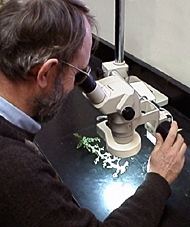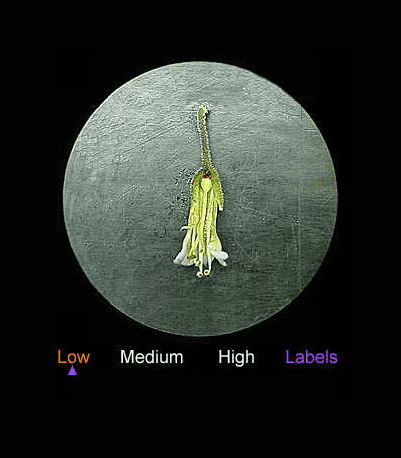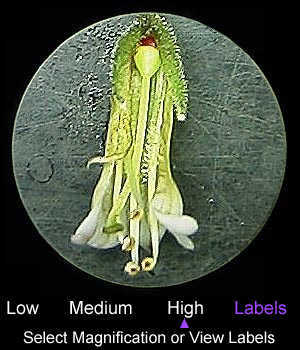 Welcome to my laboratory! Under my microscope I have a flower from a plant called Lycium exsertum. As we collect specimens we often spend time examining them under different magnifications. You can see what I am looking at through the microscope by scrolling to the bottom of this page.
Welcome to my laboratory! Under my microscope I have a flower from a plant called Lycium exsertum. As we collect specimens we often spend time examining them under different magnifications. You can see what I am looking at through the microscope by scrolling to the bottom of this page.
Looking at a Flower Under a Microscope
Below you see the same image of the flower I am viewing. The image starts with the microscope set to the lowest power, but quickly moves to higher magnification. Notice that the flower is pointing down. This is the normal direction this flower grows. To see a stable labeled image, click on the small flower picture at the bottom of the page.
Once you master the names of the parts of the flower you can test what you learned with our flower anatomy activity. You can print it out and write in your answers. Be sure to color the flower as you list each part. There is also an online version you can color and print out.

Click the image below to see a stable view of the labeled flower:

Read more about: Smashing Success
Bibliographic details:
- Article: Les Landrum's Laboratory
- Author(s): Dr. Biology
- Publisher: Arizona State University School of Life Sciences Ask A Biologist
- Site name: ASU - Ask A Biologist
- Date published:
- Date accessed:
- Link: https://askabiologist.asu.edu/laboratory
APA Style
Dr. Biology. (). Les Landrum's Laboratory. ASU - Ask A Biologist. Retrieved from https://askabiologist.asu.edu/laboratory
Chicago Manual of Style
Dr. Biology. "Les Landrum's Laboratory". ASU - Ask A Biologist. . https://askabiologist.asu.edu/laboratory
Dr. Biology. "Les Landrum's Laboratory". ASU - Ask A Biologist. . ASU - Ask A Biologist, Web. https://askabiologist.asu.edu/laboratory
MLA 2017 Style

Tucked inside this pumpkin flower is the stamen: one of the parts that is important for plant reproduction. Image by Eli Shany via Wikimedia Commons.
Be Part of
Ask A Biologist
By volunteering, or simply sending us feedback on the site. Scientists, teachers, writers, illustrators, and translators are all important to the program. If you are interested in helping with the website we have a Volunteers page to get the process started.

